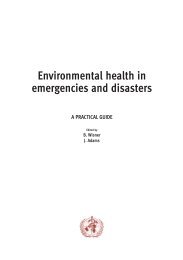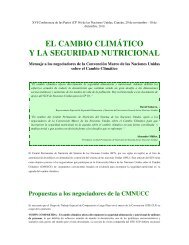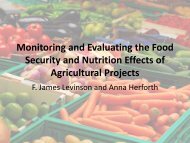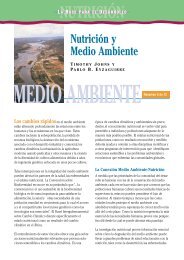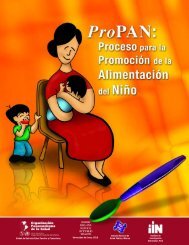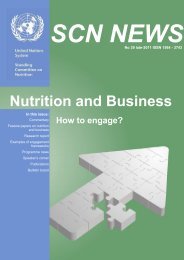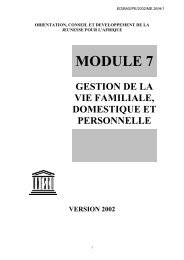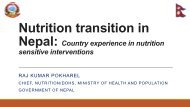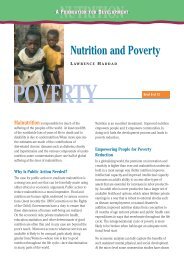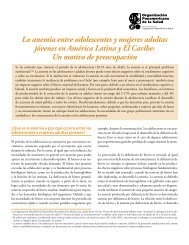SCN News No 36 - UNSCN
SCN News No 36 - UNSCN
SCN News No 36 - UNSCN
You also want an ePaper? Increase the reach of your titles
YUMPU automatically turns print PDFs into web optimized ePapers that Google loves.
www.unsystem.org/scn FEATURES 27<br />
emerge from the country examples highlighted; key enabling conditions can be summarized as follows:<br />
• Strong government action coordinated across central, state, and local levels; and across sectors;<br />
• Leadership at the highest level to ensure attention across branches of government and regions;<br />
• Inclusion of vulnerable groups and their communities in terms of mobilization and information sharing;<br />
• A strong monitoring and evaluation culture that provides a basis for incentives and correction of policy<br />
actions in the context of implementation;<br />
• Significant scaling up of public spending.<br />
Conclusions<br />
The nutrition community rightly focuses on the short routes to improving nutrition; the Lancet Series confirms<br />
that implementing a given set of targeted nutrition interventions, at scale, will result in substantial reductions<br />
in maternal and child undernutrition, mortality and disability in the short term. The urgency of achieving these<br />
goals is irrefutable. However, the focus on targeted nutrition interventions should not preclude investing in<br />
developing the foundations and the enabling environment that will allow nutrition gains to be maintained in<br />
the long term and in a sustainable way. This will require a more aggressive involvement of the nutrition<br />
community in strategies to address the underlying determinants of undernutrition. This inevitably will involve<br />
working more effectively across sectors. The nutrition community needs to be more involved and more<br />
forceful in positioning nutrition within the larger social development context. This will require working to<br />
improve nutrition not only through health, but also through agriculture and rural development, water and<br />
sanitation, education, gender, and social policy, social protection and poverty reduction strategies and<br />
programmes. Nutrition provides an opportunity to overcome some of the traditional sectoral divides, and for<br />
collaborative approaches to be designed and implemented. Clearly, the complexity of such inter-sectoral<br />
efforts has discouraged many in the past. But in current times, with the globalization of the food system,<br />
climate change, and the current food and fuel price crisis, we have no choice but to try again, with innovative<br />
approaches and new energy. And this time, we need to better document successes; we need to document<br />
not just impact, but impact pathways using well defined programme theory framework; and we need to better<br />
understand the policy processes and the political and social conditions that contribute to nutrition impact. In<br />
sum, we need strategies that effectively integrate long and short routes to improved nutrition, are multisectoral<br />
in nature, address the lifecycle, and are carefully monitored and evaluated to facilitate replication and<br />
scaling up.<br />
Contact: m.ruel@cgiar.org<br />
References<br />
Adato A, Ahmed A, Lund F (2004) Linking safety nets, social protection, and poverty reduction – Directions for Africa.<br />
2020 Africa Conference Brief 12. IFPRI:Washington, DC. (online)<br />
Adato M, Bassett L (2007) What is the potential of cash transfers to strengthen families affected by HIVand AIDS? A<br />
review of the evidence on impacts and key policy debates. Joint Learning Initiative on Children and HIV/AIDS JLICA.<br />
(online)<br />
Adato M, Hoddinott J (2007) Conditional cash transfer programs. A “magic bullet” for reducing poverty? 2020 Focus<br />
Brief on the World’s Poor and Hungry People. IFPRI:Washington, DC. (online)<br />
Bhutta ZA, Ahmed T, Black RE, Cousens S, Dewey K, Giugliani E, Haider BA, Kirkwood B, Morris SS, Sachdev HPS<br />
and Shekar M; Maternal and Child Undernutrition Study Group (2008) What works? Interventions for maternal and child<br />
undernutrition and survival. Lancet 371( 9610):417-40. (online)<br />
Black RE, Allen LH, Bhutta ZA, Caulfield LE, de Onis M, Ezzati M, Mathers C, Rivera J; Maternal and Child<br />
Undernutrition Study Group (2008) Maternal and child undernutrition: global and regional exposures and health<br />
consequences. Lancet 371(9608):243-60. (online)<br />
Bouis H (2002) Plant breeding: A new tool for fighting micronutrient malnutrition. Journal of Nutrition 132(3):491S-494S.<br />
Glassman A, Todd J, Gaarder M (2007) Performance-based incentives for health: conditional cash transfer programs in<br />
Latin America and the Caribbean. Center for Global Development Working Paper #120, Washington, DC.<br />
Hawkes C, Ruel M (2006a) The links between agriculture and health: An intersectoral opportunity to improve the health<br />
and livelihoods of the poor. Bulletin of the World Health Organization 84(12): 984-90.<br />
Hawkes C, Ruel M (2006b) Agriculture and nutrition linkages—Old lessons and new paradigms: Understanding the links<br />
between agriculture and health. 2020 Vision Focus Briefs # 13. IFPRI:Washington, DC. (online).<br />
back to contents <strong>SCN</strong> NEWS # <strong>36</strong>




